Hybrid (Gas and Geothermal) Greenhouse Simulations Aimed at Optimizing Investment and Operative Costs: A Case Study in NW Italy
Abstract
1. Introduction
2. Geological Setting
- the Pliocene marine complex, consisting of two members: the “Argille Azzurre” Formation, with scarcely permeable silt and clays, and the “Asti Sand”; this complex hosts moderate productive aquifers;
- the late Pliocene–early Pleistocene “Villafranchiano” transitional complex, composed of deltaic to continental deposits with alternating sandy gravels and silty clays and hosting a multilayered aquifer representing the most-exploited groundwater system of the Turin area because of its productivity and better groundwater quality than the shallow aquifer;
- the lower Pleistocene–Holocene “Alluvial deposits” complex, which hosts a shallow, unconfined aquifer formed of highly permeable coarse gravels and sands of fluvioglacial origin, with silty-clayey intercalations.
3. Assessments Aimed at Sizing the Shallow Geothermal Plant
3.1. Monitoring of Ground Temperature and Grout Ageing
3.2. Field GRT and Interpretation of the Obtained Parameters
- Tf(t) is the average fluid temperature (Tin and Tout) depending on the test time, expressed in °C.
- Q is the injected power per unit of length and time, expressed in W and derived from q = Q/H (H is the drilling depth).
- π is equal to 3.14.
- λ is the ground thermal conductivity, expressed in W*m−1K−1.
- γ is the Eulero Constant, equal to 0.5772.
- α is the thermal diffusivity, expressed in m2/s.
- t is the test time, expressed in s.
- r is the borehole radius, expressed in m.
- Rb is the borehole thermal resistance, expressed in K/(W/m).
- Tg is the undisturbed temperature, expressed in °C.
3.3. Numerical Simulation of the Field GRT
4. Short- and Long-Term Numerical Simulations
4.1. Geological, Hydrogeological, and Thermo-Physical Model
4.2. Geometrical and Thermo-Technical Model
5. Results
- specific ground temperature measures and monitoring of the grout ageing;
- real geothermal plant simulations (short- and long-term)
5.1. Monitoring of the Grout Ageing and Ground Temperature
5.2. Real Geothermal Plant Simulation
- (a)
- switching the plant on over 120 days without any interruption, representing the four months with the greatest thermal energy demands (colder months);
- (b)
- switching it on over 120 days followed by switching it off during the remaining months over a period of 5 years.
Continuous Plant Operation over Four Heating Months
5.3. On and Off Cycles over Five Years’ Operation
6. Discussion and Conclusions
Author Contributions
Funding
Data Availability Statement
Conflicts of Interest
References
- IEA (International Energy Agency). Energy Efficiency 2022; IEA: Paris, France, 2022; Available online: https://www.iea.org/reports/energy-efficiency-2022 (accessed on 18 January 2023).
- IEA (International Energy Agency). Heating; IEA: Paris, France, 2022; Available online: https://www.iea.org/reports/energy-efficiency-2022 (accessed on 18 January 2023).
- UNFCCC. UN Climate Change Conference UK. 2021. Available online: https://ukcop26.org/it/iniziale/ (accessed on 31 October 2022).
- UNFCC. Sharm El-Sheikh Climate Change Conference-November 2022. 2022. Available online: https://unfccc.int/cop27 (accessed on 31 January 2023).
- European Commission. New Studies Look Closer at Decarbonising Heating and Cooling Sector. News Article, Directorate-General for Energy. 2022. Available online: https://commission.europa.eu/news/new-studies-look-closer-decarbonising-heating-and-cooling-sector-2022-06-13_en (accessed on 18 January 2023).
- IEA (International Energy Agency). Buildings; IEA: Paris, France, 2022; Available online: https://www.iea.org/reports/energy-efficiency-2022 (accessed on 18 January 2023).
- UN (United Nations) Environment programme. Global Status Report for Buildings and Constructions: Towards a Zero-Emissions, Efficient and Resilient Buildings and Construction Sector. Global Alliance for Buildings and Construction. 2022. Available online: https://www.unep.org/resources/publication/2022-global-status-report-buildings-and-construction (accessed on 18 January 2023).
- D’Arpa, S.; Colangelo, G.; Starace, G.; Petrosillo, I.; Bruno, D.E.; Uricchio, V.; Zurlini, G. Heating requirements in greenhouse farming in southern Italy: Evaluation of ground-source heat pump utilization compared to traditional heating systems. Energy Effic. 2016, 9, 1065–1085. [Google Scholar] [CrossRef]
- Sanford, S. Reducing Greenhouse Energy Consumption—An Overview; A3907-01; Cooperative Extension Publishing: Madison, WI, USA, 2011; pp. 1–15. [Google Scholar]
- Ahamed, M.S.; Guo, H.; Tanino, K. Energy saving technique for reducing the heating cost of conventional greenhouses. Biosyst. Eng. 2019, 178, 9–33. [Google Scholar] [CrossRef]
- Muñoz-Liesa, J.; Royapoor, M.; Cuerva, E.; Gassó-Domingo, S.; Gabarrell, X.; Josa, A. Building-integrated greenhouses raise energy co-benefits through active ventilation systems. Build. Environ. 2021, 208, 108585. [Google Scholar] [CrossRef]
- Benli, H.; Dormus, A. Performance analysis of a latent heat storage system with phse change material for new designed solar collectors in greenhouse heating. Sol. Energy 2019, 83, 2109–2119. [Google Scholar] [CrossRef]
- Sun, W.; Wei, X.; Zhou, B.; Lu, C.; Guo, W. Greenhouse heating by energy transfer between greenhouses: System design and implementation. Appl. Energy 2022, 325, 119815. [Google Scholar] [CrossRef]
- Le, A.T.; Wang, L.; Wang, Y.; Li, D. Measurement investigation on the feasibility of shallow geothermal energy for heating and cooling applied in agricultural greenhouses of Shouguang City: Ground temperature profiles and geothermal potential. Inf. Process. Agric. 2021, 8, 251–269. [Google Scholar] [CrossRef]
- Al-Helal, I.; Alsadon, A.; Marey, S.; Ibrahim, A.; Shady, M.; Abdel-Ghany, A. Geothermal Energy Potential for Cooling/Heating Greenhouses in Hot Arid Regions. Atmosphere 2022, 13, 105. [Google Scholar] [CrossRef]
- Russo, G.; Anifantis, A.S.; Verdiani, G.; Scarascia Mugnozza, G. Environmental analysis of geothermal heat pump and LPG greenhouse heating systems. Biosyst. Eng. 2014, 127, 11–23. [Google Scholar] [CrossRef]
- El Haj Assad, M.; Ahmadi, M.; Sadeghzadeh, M.; Yassin, A.; Issakhov, I. Renewable hybrid energy systems using geothermal energy: Hybrid solar thermal–geothermal power plant. Int. J. Low-Carbon Technol. 2021, 16, 518–530. [Google Scholar] [CrossRef]
- Forno, M.G.; De Luca, D.A.; Bonasera, M.; Bucci, A.; Gianotti, F.; Lasagna, M.; Lucchesi, S.; Pelizza, S.; Piana, F.; Taddia, G. Synthesis on the Turin subsoil stratigraphy and hydrogeology (NW Italy). Alp. Mediterr. Quat. 2018, 31, 147–170. [Google Scholar] [CrossRef]
- Giordano, N.; Comina, C.; Mandrone, G. Borehole thermal energy storage (BTES). First results from the injection phase of a living lab in Torino 8NW Italy). Renew. Energy 2016, 86, 993–1008. [Google Scholar] [CrossRef]
- Giordano, N.; Arato, A.; Comina, C.; Mandrone, G. Time-laps electrical resistivity imaging of the thermally affected zone of a Borehole Thermal Energy Storage system near Torino (Northern Italy). J. Appl. Geophys. 2017, 140, 123–134. [Google Scholar] [CrossRef]
- Piana, F.; Fioraso, G.; Irace, A.; Mosca, P.; d’Atri, A.; Barale, L.; Falletti, P.; Monegato, G.; Morelli, M.; Tallone, S.; et al. Geology of Piemonte region (NW Italy, Alps-Apennines interference zone). J. Maps 2017, 13, 395–405. [Google Scholar] [CrossRef]
- Forno, M.G.; Gianotti, F.; Storti, U. Geomorphology of the Po tluvial terraces in Turin deduced by new subsoil data (NW Italy). Water 2022, 14, 2872. [Google Scholar] [CrossRef]
- Chicco, J.M.; Mandrone, G. Modelling the energy production of a borehole thermal energy storage (BTES) system. Energies 2022, 15, 9587. [Google Scholar] [CrossRef]
- Saito, T.; Hamamoto, S.; Ueki, T.; Ohkubo, S.; Moldrup, P.; Kawamoto, K.; Komatsu, T. Temperature change affected groundwater quality in a confined marine aquifer during long-term heating and cooling. Water Res. 2016, 94, 120–127. [Google Scholar] [CrossRef]
- Riedel, T. Temperature-associated changes in groundwater quality. J. Hydrol. 2019, 572, 206–212. [Google Scholar] [CrossRef]
- Chicco, J.M.; Comeau, F.-A.; Casasso, A.; Comina, C.; Giordano, N.; Mandrone, G.; Raymond, J. Alternative Use of Artificial Quarry Lakes as a Source of Thermal Energy for Greenhouses. Water 2021, 13, 3560. [Google Scholar] [CrossRef]
- Chicco, J.M.; Mandrone, G. How a sensitive analysis on the coupling geology and borehole heat exchanger characteristics can improve the efficiency and production of shallow geothermal plants. Heliyon 2022, 8, e09545. [Google Scholar] [CrossRef]
- Thermal Use of the Underground-Fundamentals, Approvals, Enironmental Aspect; VDI 4640 Blatt 1; Engl. VDI-Gesellschaft Energie und Umwelt: Düsseldorf, Germany, 2010; pp. 1–33.
- Eklöf, C.; Gehlin, S. Ted-a Mobile Equipment for Thermal Response Test: Testing and Evaluation. Master’s Thesis, Luleå University of Technology, Norrbotten, Sweden, 1996; pp. 1–62. [Google Scholar]
- Raymond, J.; Mercier, S.; Nguyen, L. Designing coaxial ground heat exchangers with a thermally enhanced outer pipe. Geotherm. Energy 2015, 3, 7. [Google Scholar] [CrossRef]
- Claesson, J.; Dunand, A. Heat Extraction from the Ground by Horizontal Pipes: A Mathematical Analysis; Byggforskningsrådet: Stockholm, Sweden, 1983; Available online: https://lucris.lub.lu.se/ws/portalfiles/portal/4375488/8146470 (accessed on 4 February 2023).
- Javed, S.; Spitler, J. Calculation of Borehole Thermal Resistance. In Advances in Ground-Source Heat Pump Systems; Woodhead Publishing: Cambridge, UK, 2016; Volume 1, pp. 63–95. ISBN 9780081003114. [Google Scholar]
- Kuosa, M.; Rahiala, S.; Tallinen, K.; Mäkilä, T.; Lampinen, M.; Lahdelma, R.; Pulkkinen, L. Mass flow controlled district heating with an extract air heat pump in apartment buildings: A practical concept study. Appl. Therm. Eng. 2019, 157, 113745. [Google Scholar] [CrossRef]
- Diersch, H.-J.G. FEFLOW–Finite Element Modeling of Flow, Mass and Heat Transport in Porous and Fractured Media. In Earth and Environmental Science; Springer: Berlin/Heidelberg, Germany, 2014; Volume 1, p. 996. [Google Scholar] [CrossRef]
- Diersch, H.-J.G. Using and testing the algebraic multigrid equation solver SAMG in FEFLOW. FEFLOW White Pap. 2009, 3, 25–36. [Google Scholar]
- Lanahan, M.; Tabares-Velasco, P.C. Seasonal Thermal-Energy Storage: A Critical Review on BTES Systems, Modeling, and System Design for Higher System Efficiency. Energies 2017, 10, 743. [Google Scholar] [CrossRef]
- Catolico, N.; Ge, S.; McCartney, J.S. Numerical Modeling of a Soil-Borehole Thermal Energy Storage System. Vadose Zone J. 2016, 15, 1–17. [Google Scholar] [CrossRef]
- Blank, L.; Meneses Rioseco, E.; Caiazzo, A.; Wilbrandt, U. Modeling, simulation, and optimization of geothermal energy production from hot sedimentary aquifers. Comput. Geosci. 2021, 25, 67–104. [Google Scholar] [CrossRef]
- Gao, C.; Zhang, L.; Sun, C.; He, J. The numerical simulation of heat and mass transfer on geothermal system. A case study Laoling area, Shandong, China. Math. Probl. Eng. 2022, 2022, 1–11. [Google Scholar] [CrossRef]
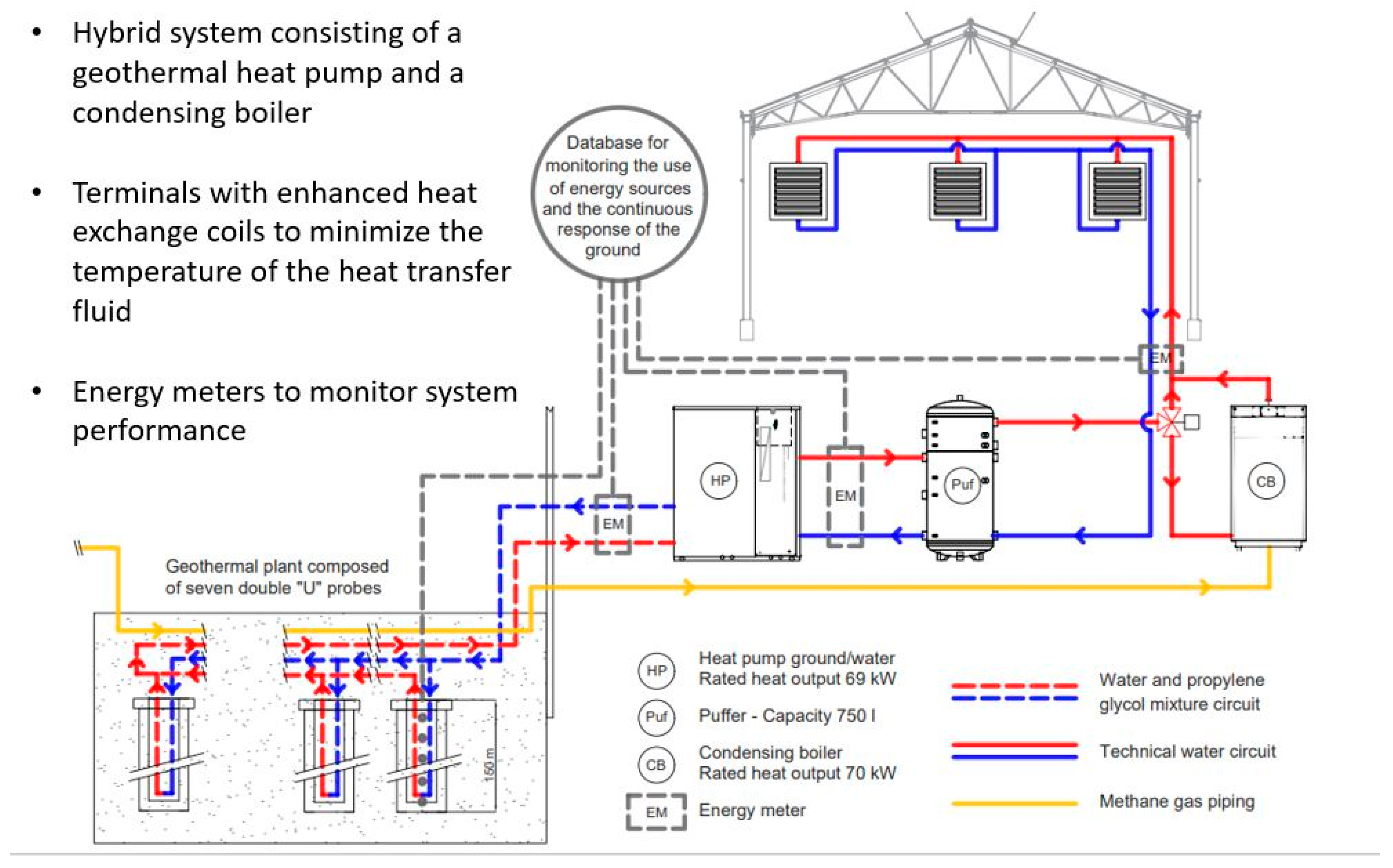
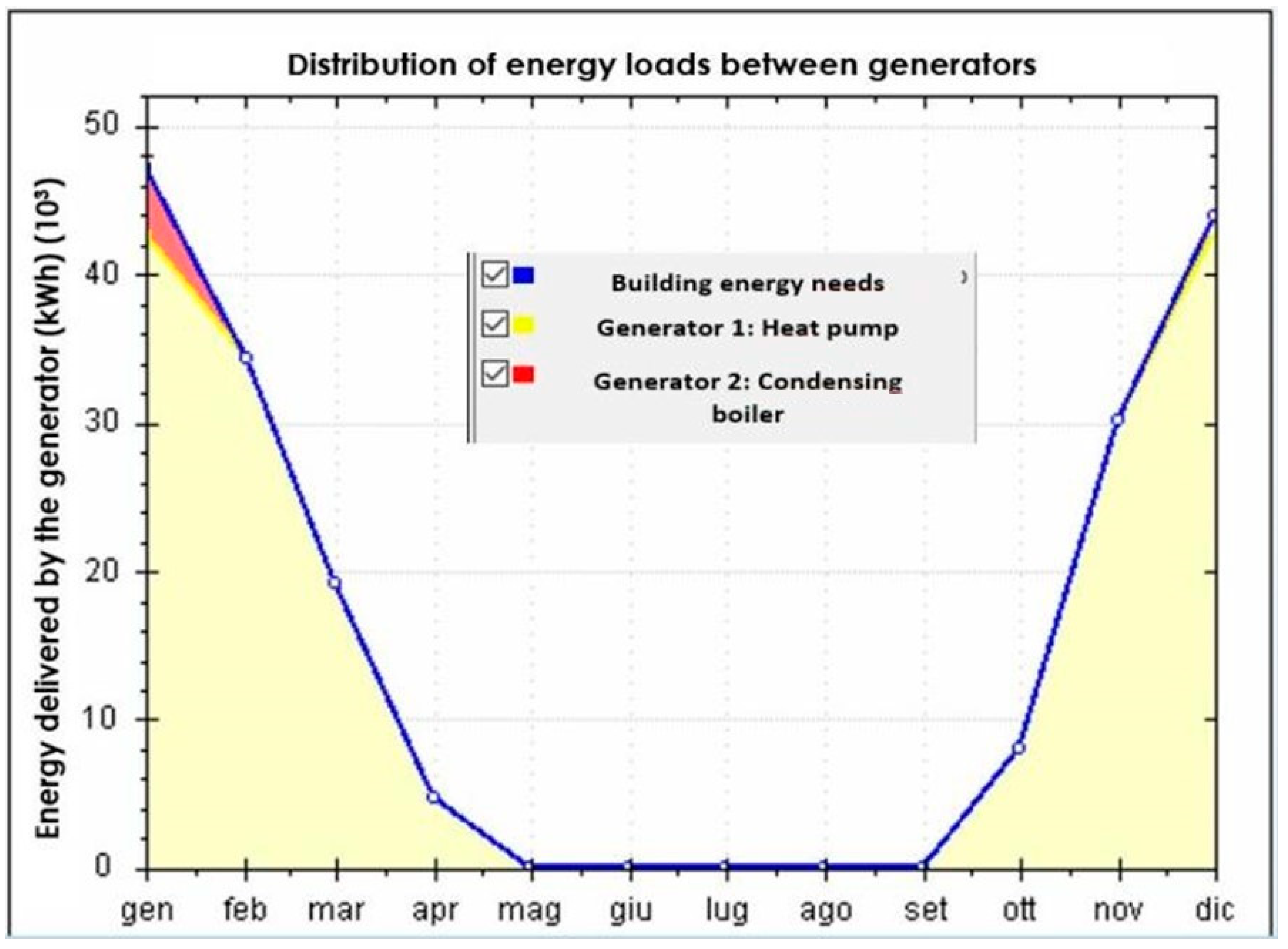

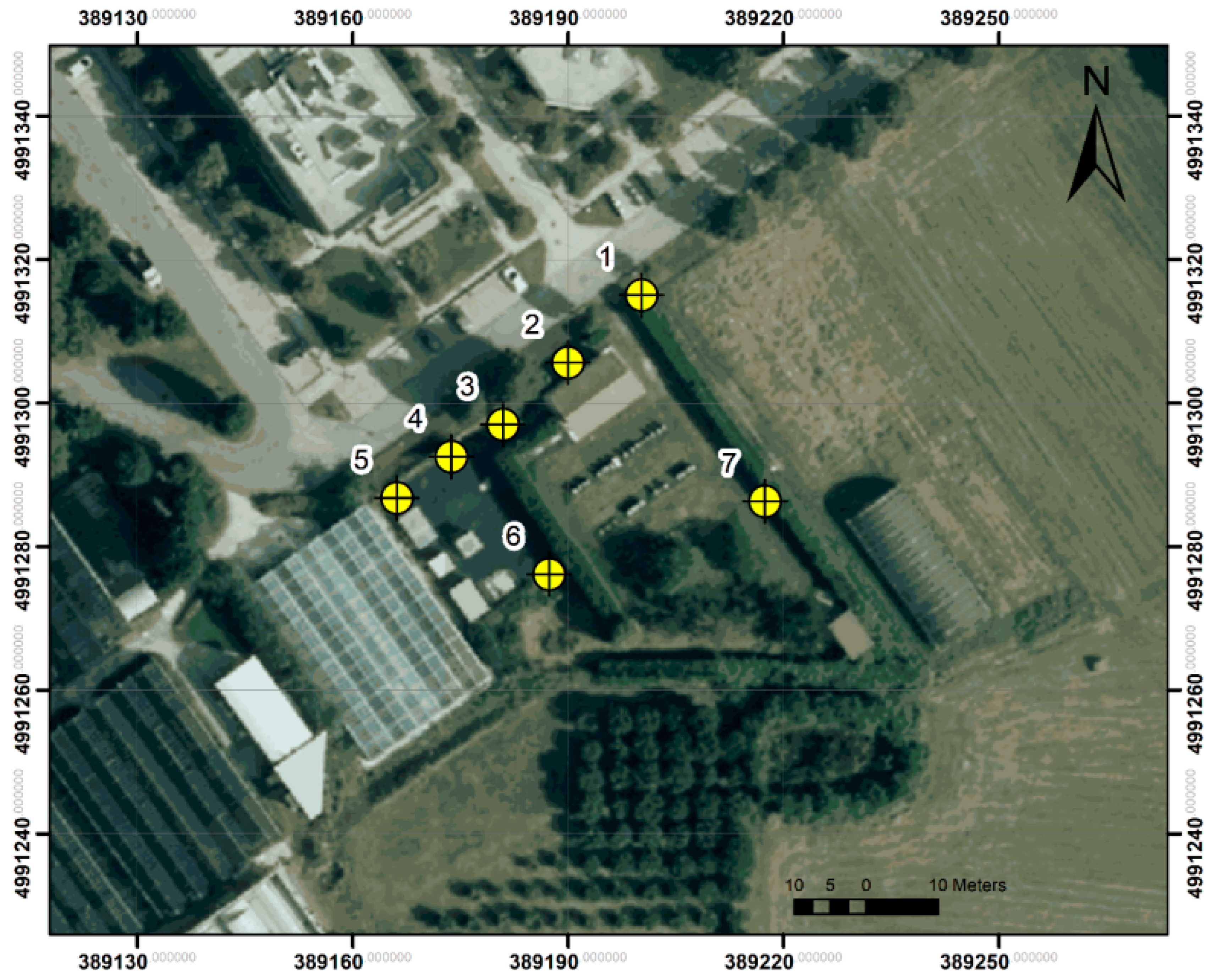
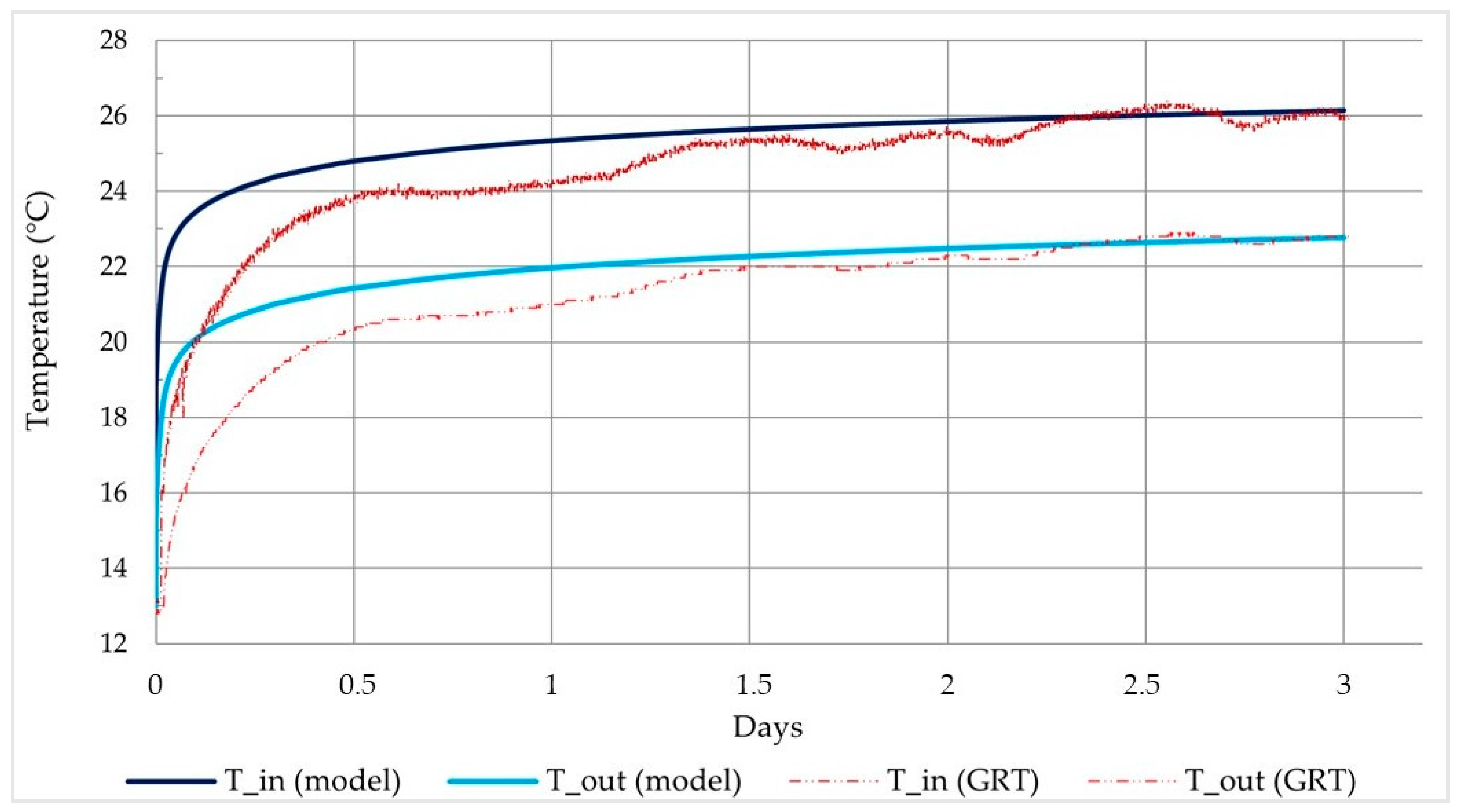
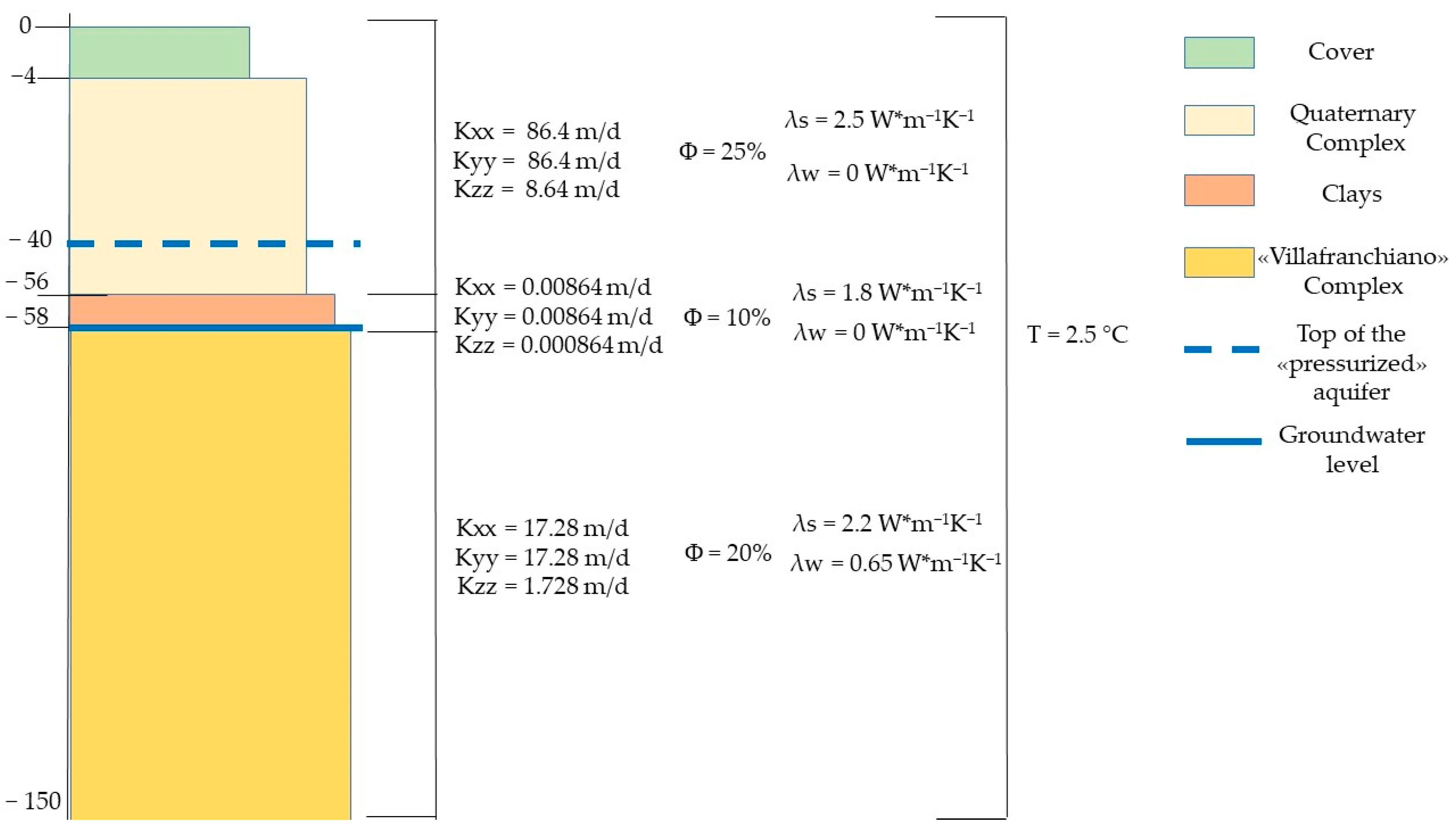

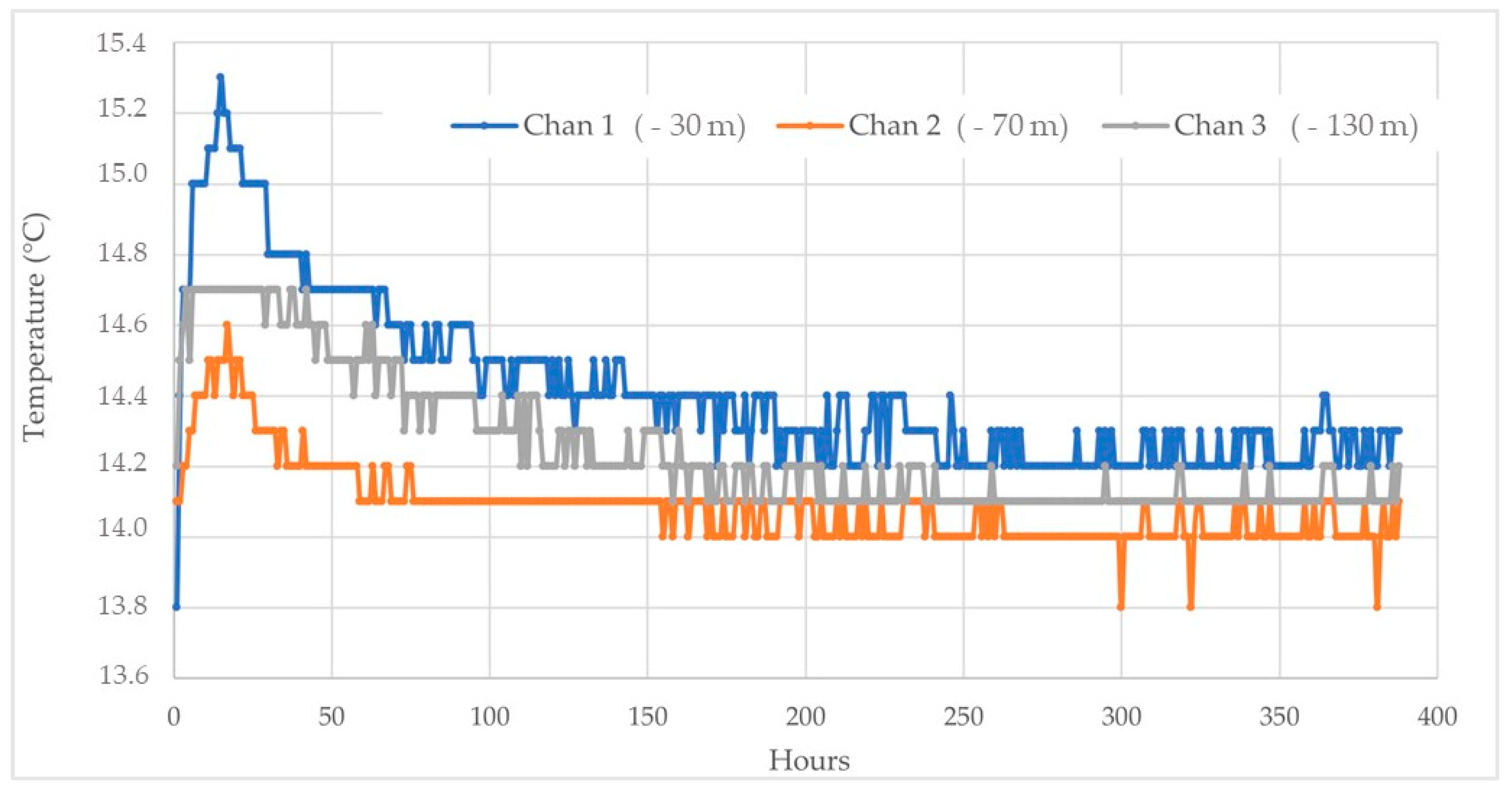
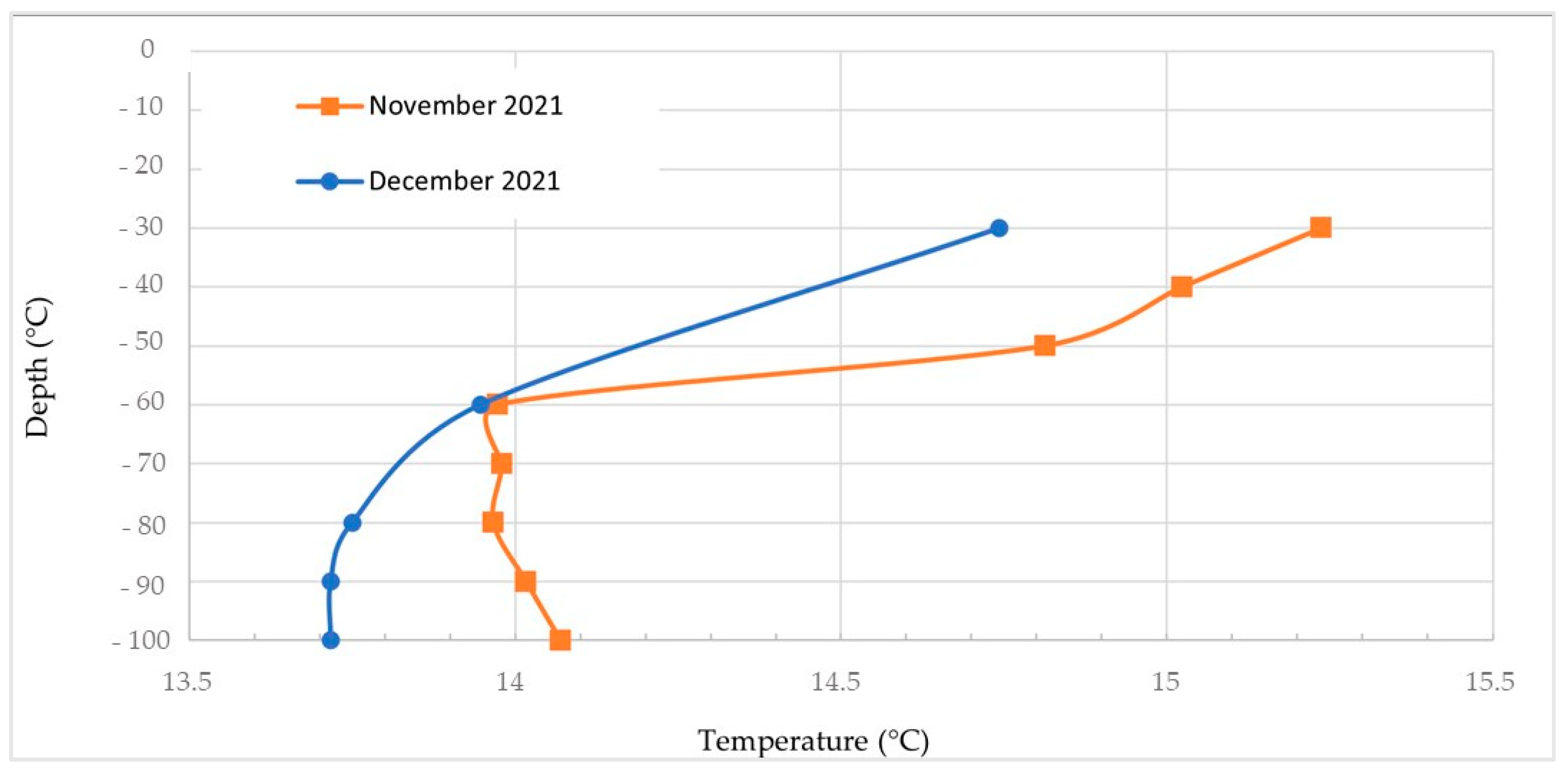
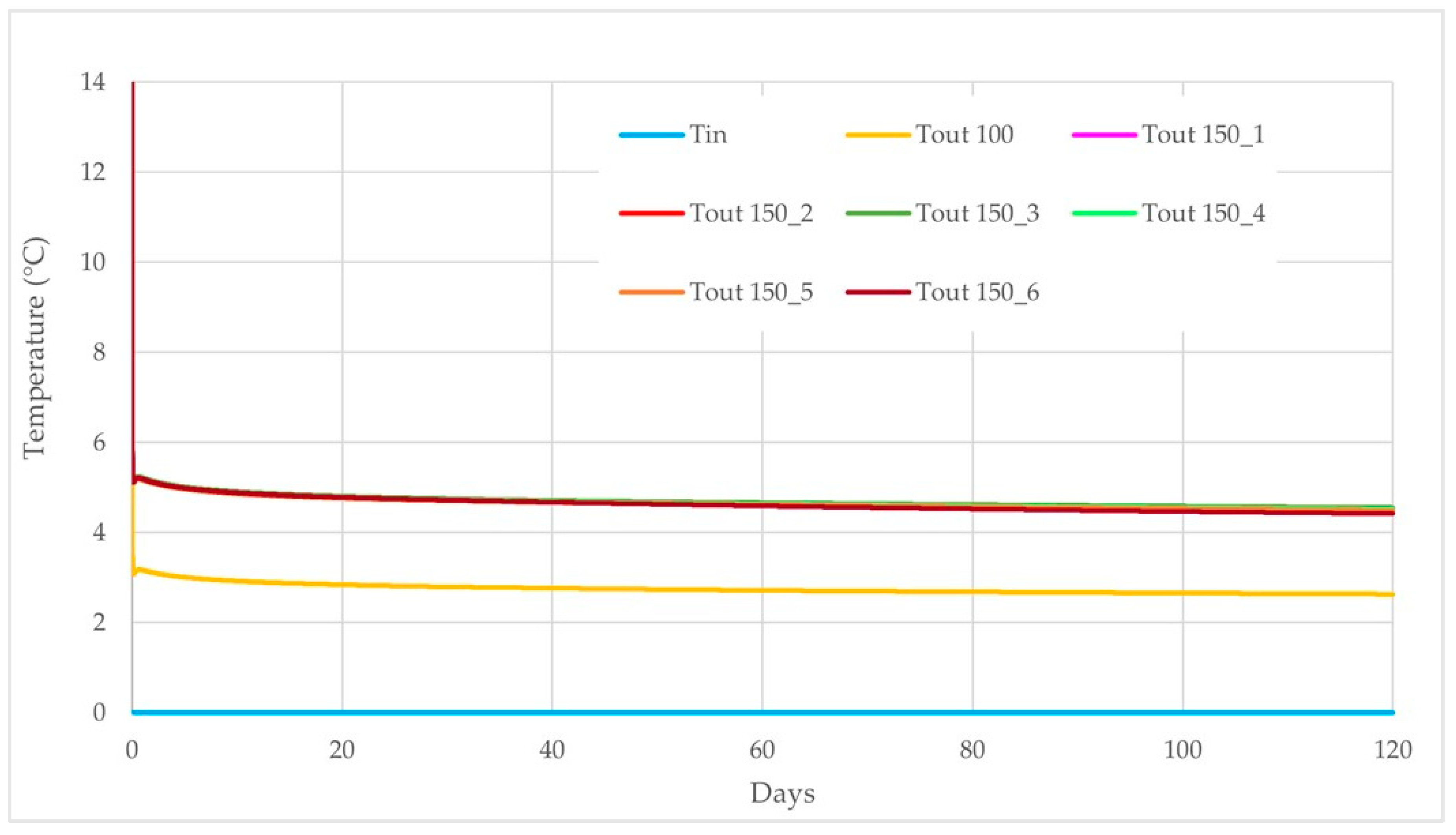
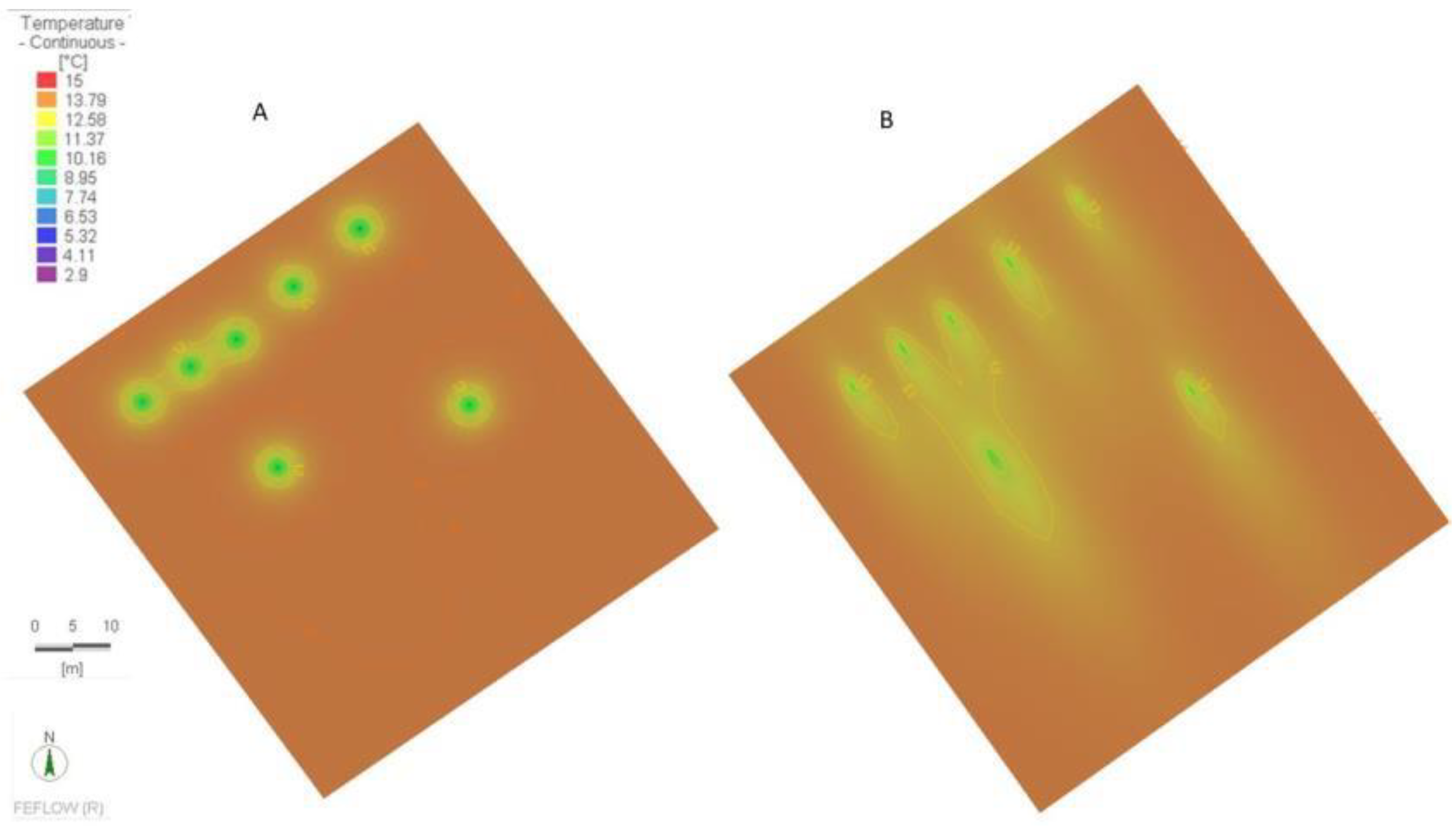
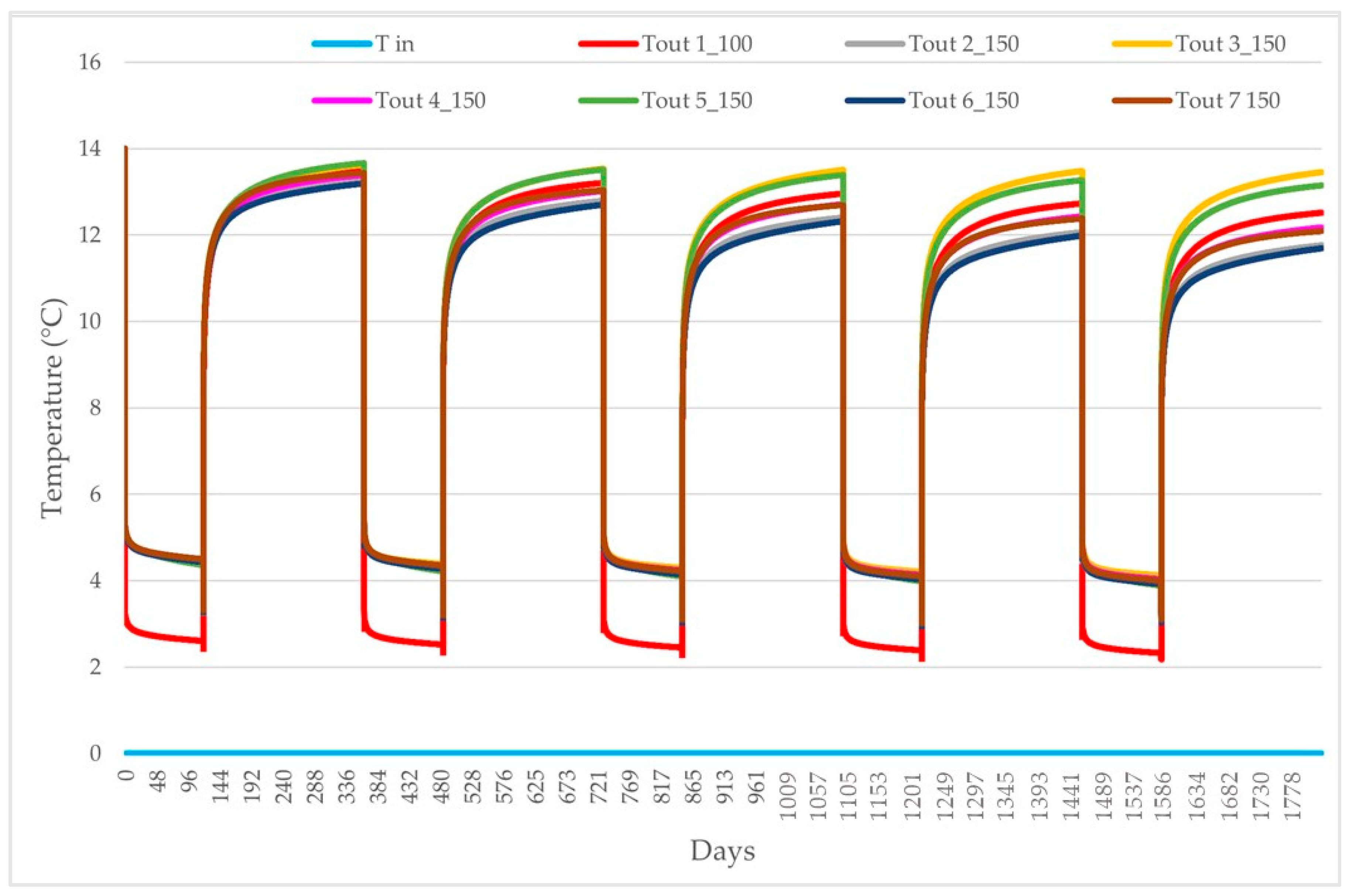
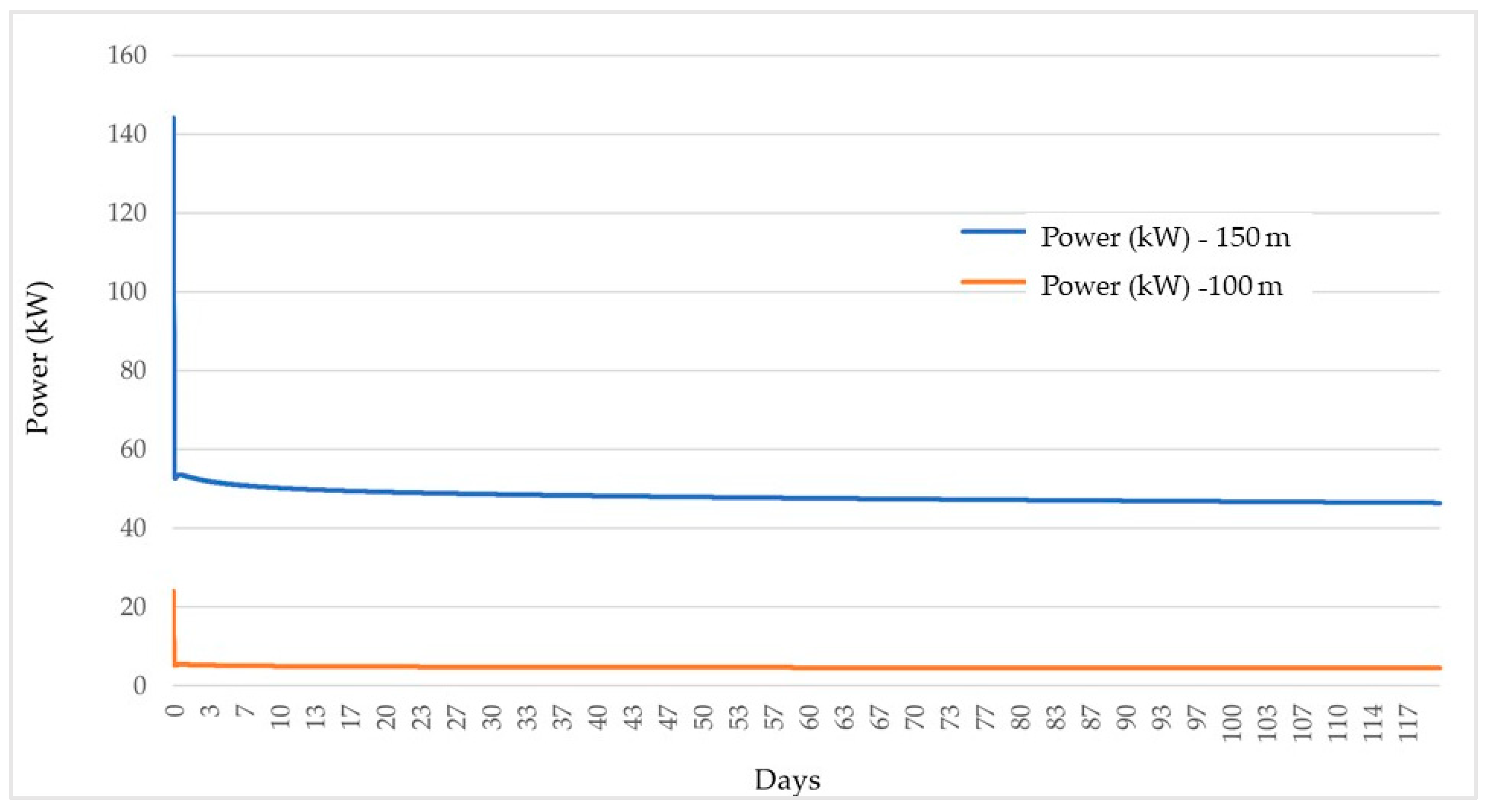

| Lithology | Depth (m) | Hydraulic Conductivity (K, m/d) | Porosity (θ, %) | Temp. (°C) | Groundwater Level (m) |
|---|---|---|---|---|---|
| “Quaternary” Complex | From 0 to −56 | 86.4 | 25 | 14 | −58 |
| Clays | From −56 to −58 | 0.00864 | 10 | 14 | −58 |
| “Villafranchiano” Complex | From −58 to −100 | 17.28 | 20 | 14 | −58 |
| Pipe Configuration | L (m) | din (m) | bin (m) | dout (m) | bout (m) | D (m) | λin (W*m−1K−1) | λout (W*m−1K−1) |
|---|---|---|---|---|---|---|---|---|
| Double U | 60 | 0.026 | 0.0023 | 0.032 | 0.0029 | 0.15 | 0.42 | 0.42 |
Disclaimer/Publisher’s Note: The statements, opinions and data contained in all publications are solely those of the individual author(s) and contributor(s) and not of MDPI and/or the editor(s). MDPI and/or the editor(s) disclaim responsibility for any injury to people or property resulting from any ideas, methods, instructions or products referred to in the content. |
© 2023 by the authors. Licensee MDPI, Basel, Switzerland. This article is an open access article distributed under the terms and conditions of the Creative Commons Attribution (CC BY) license (https://creativecommons.org/licenses/by/4.0/).
Share and Cite
Chicco, J.M.; Fonte, L.; Mandrone, G.; Tartaglino, A.; Vacha, D. Hybrid (Gas and Geothermal) Greenhouse Simulations Aimed at Optimizing Investment and Operative Costs: A Case Study in NW Italy. Energies 2023, 16, 3931. https://doi.org/10.3390/en16093931
Chicco JM, Fonte L, Mandrone G, Tartaglino A, Vacha D. Hybrid (Gas and Geothermal) Greenhouse Simulations Aimed at Optimizing Investment and Operative Costs: A Case Study in NW Italy. Energies. 2023; 16(9):3931. https://doi.org/10.3390/en16093931
Chicago/Turabian StyleChicco, Jessica Maria, Leonardo Fonte, Giuseppe Mandrone, Andrea Tartaglino, and Damiano Vacha. 2023. "Hybrid (Gas and Geothermal) Greenhouse Simulations Aimed at Optimizing Investment and Operative Costs: A Case Study in NW Italy" Energies 16, no. 9: 3931. https://doi.org/10.3390/en16093931
APA StyleChicco, J. M., Fonte, L., Mandrone, G., Tartaglino, A., & Vacha, D. (2023). Hybrid (Gas and Geothermal) Greenhouse Simulations Aimed at Optimizing Investment and Operative Costs: A Case Study in NW Italy. Energies, 16(9), 3931. https://doi.org/10.3390/en16093931






